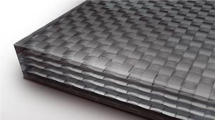Abstract
Functional integration of smart materials in sheet metal enables lightweight composite parts which are enhanced by new functionalities. Locally integrated piezoceramic/metal composites consist of a prefabricated array of ten parallel piezoceramic macro-fibers with dimensions of 0.277 mm by 0.232 mm by 10 mm which are joined in micro-formed cavities within the surface of an aluminum sheet metal. By the use of joining by forming, the interference–fit, preload and form–fit of macro-fiber arrays are achieved in a single process step. The paper describes investigations of the joining by forming process in formal planned experiments using the design of experiments method. The influence of the dimensions and preparation of the joining partners, the maximum forming force and the velocity of the forming stamp are varied. The interference–fit and preload depend on the maximum forming force. In contrast, the quality of the form–fit is primarily related to the geometric dimensions and the forming force. Fiber fractures and incipient cracks are the major failure mechanisms during joining by forming of the macro-fibers. The number of cracks is significantly reduced by the use of lower die velocities, lower maximum joining forces and the introduction of additional geometric elements in the microstructure of the metal surface. Concluding, constraints with regard to the design of parts and the process are derived from the experiments.
















Similar content being viewed by others
References
Dawson P, Boyce D, MacEwen S, Rogge R (2001) On the influence of crystal elastic moduli on computed lattice strains in AA-5182 following plastic straining. Mater Sci Eng A 313:123–144
Groche P, Türk M (2011) Smart structures assembly through incremental forming. CIRP Ann Manuf Technol 60(1):21–24
Heywang W, Lubitz K, Wersing W (eds) (2008) Piezoelectricity: evolution and future of a technology. Springer series in materials science, vol 114. Springer, Berlin
Janas VF, Safari A (1995) Overview of fine-scale piezoelectric ceramic/polymer composite processing. J Am Ceram Soc 78(11):2945–2955
Kobayashi M, Jen CK, Lévesque D (2006) Flexible ultrasonic transducers. IEEE IEEE Trans Ultrason 53(8):1478–1485
Mori K, Bay N, Fratini L, Micari F, Tekkaya AE (2013) Joining by plastic deformation. CIRP Ann Manuf Techn (in press)
Neugebauer R, Wittstock V, Illgen A, Naumann G (2006) Piezo-based actuator-sensor-units for uniaxial vibration reduction in machine tools. Prod Eng Res Dev Ger Ann Ger Acad Soc Prod Eng 13(2):211–216
Neugebauer R, Koriath HJ, Müller M (2013) Assembly of smart adaptronic piezo-metal composites by use of prefabricated batches of piezoceramic micro parts. In: Proceedings of the SPIE 8692, sensors and smart structures technologies for civil, mechanical, and aerospace systems, vol 8692, pp 869224-1–869224-9. doi:10.1117/12.2010504
Neugebauer R, Schubert A, Koriath HJ, Jahn SF, Müller B, Müller M (2013) Microfabricated piezo-metal substructures for sensor integration in large sheet metal parts. In: Proceedings of the 13th euspen international conference, vol 2, pp 190–112
Richeson M, Erturun U, Waxman R, Mossi K, Kunikata J, Asanuma H (2010) Characterization of a Pt-core PZT fiber/Al matrix composite. In: Proceedings of the SPIE 7644, behavior and mechanics of multifunctional materials and composites, vol 7644, pp 764429-1–764429-11. doi:10.1117/12.847576,
Schubert A, Drossel WG, Pohl R, Kranz B (2010) Investigation of a force-locked connection of micro piezo elements with aluminium carrier material. Prod Eng 4(4):399–405
Schubert A, Jahn SF, Müller B (2013) Microstructuring by a combination of micro impact extrusion and shear displacement forming. Key Engineering Materials vol 554–557:893–899. doi:10.4028/www.scientific.net/KEM.554-557.893
Schubert A, Wittstock V, Koriath HJ, Jahn SF, Peter S, Müller B, Müller M (2013) Smart metal sheets by direct functional integration of piezoceramic fibers in microformed structures. Microsyst Technol 1–10. doi:10.1007/s00542-013-1836-6
Veilleux J, Kruger SE, Wu K, Blouin A (2013) Multi-element, high-temperature integrated ultrasonic transducers for structural health monitoring. In: Proceedings of the SPIE 8693, smart sensor phenomena, technology, networks, and systems integration, vol 86930, pp 1–8. doi:10.1117/12.2009868
Zhou D (2003) Experimental investigation of non-linear constitutive behavior of pzt piezoceramics. PhD thesis, Karlsruhe Institute of Technology
Acknowledgments
This research is supported by the Deutsche Forschungsgemeinschaft (DFG) in context of the Collaborative Research Centre/Transregio 39 PT-PIESA, subproject A2.
Author information
Authors and Affiliations
Corresponding author
Rights and permissions
About this article
Cite this article
Schubert, A., Wittstock, V., Jahn, S.F. et al. Joining by forming of piezoceramic macro-fiber arrays within micro-structured surfaces of aluminum sheets. Prod. Eng. Res. Devel. 8, 195–205 (2014). https://doi.org/10.1007/s11740-013-0498-7
Received:
Accepted:
Published:
Issue Date:
DOI: https://doi.org/10.1007/s11740-013-0498-7




